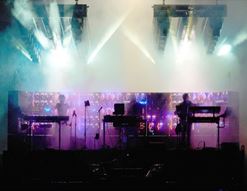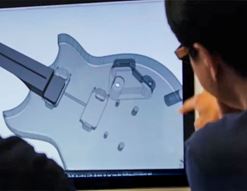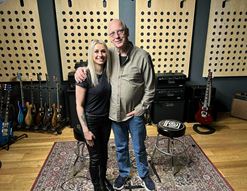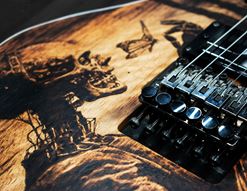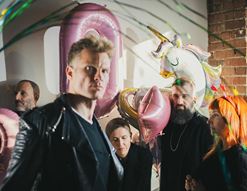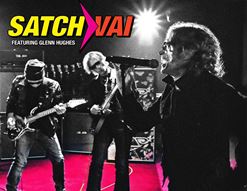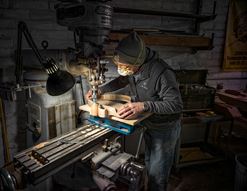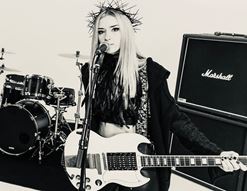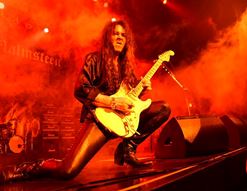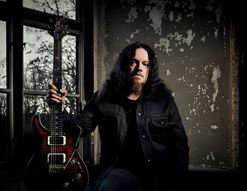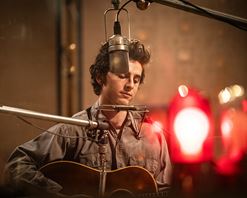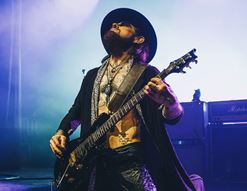Andy Timmons is a lot of fun to talk to. So much so, in fact, that during our interview, we drifted off-piste so often that we ran out of time and had to schedule a whole extra interview slot just to fit some guitar chat in! Andy, of course, is a legendary guitarist and composer, famous equally from his hair metal days with Danger Danger as he is for his solo recordings, where he blends the touch of Jeff Beck, the surprise of Pat Metheny and the groove of Earth, Wind and Fire into a musical tapas that feels colourful and vibrant, yet cohesive and lyrical.
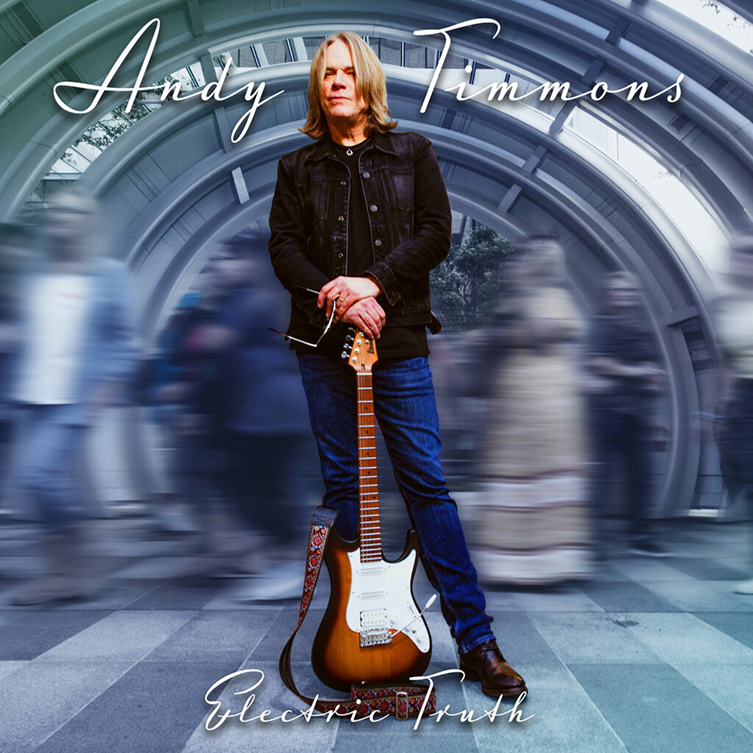
His newest album, Electric Truth, sees him teaming up with writer/producer Josh Smith to make a record full of live band performances, beautiful moods and, naturally, a ton of top notch guitar playing! We joined Andy (twice) via Zoom from his Dallas home to get the lowdown on the recording process, his enduring 30+ year partnership with Ibanez, and a host of other insights along the way.
Andy Timmons Interview
guitarguitar: So, your new record, Electric Truth: am I right in saying this time you went across to Los Angeles and your producer Josh Smith sort of project managed it and picked out a band and so on?
Andy Timmons: Absolutely, that was what made it so much fun for me! I’d met Josh over the phone. Basically, I was seeing him on YouTube videos and hearing his recordings, and I was a fan. He was obviously very steeped in Blues but I could hear the Jazz; I could hear the Robben Ford, the Danny Gatton. This is a guy I loved to hear, so I reached out to him. We instantly hit it off and he’d just finished building his dream studio so he invited me out to record. It just seemed right, you know what I mean? You meet a lot of people along the way in this business who say ‘We gotta get together! We gotta play!’ Does it ever happen? Usually not! But I just felt that this would be a fun thing.
I really liked the feel of his band, the guys he’s playing with. So I said, ‘Look: let’s both write some tunes, I’ll come out, you produce and do whatever you think is gonna be best’. In a way, it takes a bit of pressure off of me, because usually I’m producing or co-producing my own records. It was really fun for me to kinda let go of the reigns a little bit, have fun and play. We did most of the record in about two and a half days. I came over a few days before NAMM 2020 and spent one day finishing the tunes, making charts, preproductions then we brought the band in to see what we could do. All the band stuff got done in two days, and I was supposed to come back in March but of course nobody went anywhere in March 2020! (laughs) I finished it little by little, back here at my studio and then we just mixed long-distance. There’s an amazing recording engineer, Alan Hertz, who works for Josh: he did an amazing job of mixing the record. And I absolutely love the band on this record: it’s Lemar Carter on drums, Travis Carlton on bass and Deron Johnson on keyboards. Kind of a dream team!
GG: Well, that feel you mentioned definitely translates to the listener. I was about to ask you if you all tracked live, but it certainly has a live feel, nice interplay, and all of that. So the material: you mentioned that you wrote some songs and Josh wrote some.
AT: Yeah.
GG: Do you have stockpiles of ideas and songs that you’re waiting to work on?
AT: There was one tune I’d written a few years earlier called Grace. I was inspired by Billy Cox doing one of those Jimi Hendrix Experience tours. The other tunes though, like EWF, Apocryphal and a couple that didn’t make the record, I was writing with a Telecaster because of Josh! He’s always famously using a Tele-style guitar. So yeah, most of them were kinda written with the idea of this record. Words Fail and One Last Time - the two ballads on the record - they all happened pretty quickly around that time. Some had been around for about a year, in fact I’d done a side project band that we called Electric Truth and some came from that. I think the majority of the writing wa sme, and then Josh helped write EWF and Johnny T.
"It felt so good because it was a band playing live together. That's the beauty of the record overall, for me."
GG: One of my favourite things about your music is your melodic sense. I kind of expect you to be great at shredding (Andy laughs), because any pro after a certain point, I’m like, ‘Yeah, he’s gonna be able to rip it!’, but it’s the beautiful melodic stuff that gets me.
AT: Ah, thank you.
GG: When you’re writing, is it like a chord progression first? Or do you get melodies that come to you and you then figure them out on the guitar? How do those melodies arrive?
AT: Well, it’s a variety of ways and there’s no one particular way. Sometimes there’ll be a chord progression I’ll compose over but a lot of times, it comes together, you know, so to speak. For a while there, I was entirely composing chord and melody together. After Resolution, (plays a wonderful rendition), I was hearing quarter melody a lot and I was just letting my ear guide what I wanted to hear. It’s kind of natural, and I’m not thinking about it too much. Your ear develops and gets an instinct, a kind of ‘if then, then this’ idea. It’s true of me and I’m sure it comes from all the great melodies that I’ve learned or absorbed over the years. There’s definitely what I call the ‘auralect’, which is the - I had to coin my own phrase because I hadn’t heard anybody talk about it - but it's the intellect of the ear: the instinct that you develop from all the things you’ve taken in. I always mention Lennon & McCartney: how did they become such great writers? They knew nothing about harmony or theory or anything, but they learned probably hundreds, if not thousands of tunes! Through that, you get this idea of what you love and what you think sounds great. It’s gonna be different for everybody.

(Photo: Teresa Jolie)
So, some of it is the combination of all the things I’ve taken in, but then also having played a lot of jazz. Certainly in rock guitar, we tend to think ‘key and scale’, right? Aminor: I got this! Pentatonics, Dorian or whichever scale is appropriate, and we can shred and it can be cool but the beauty of jazz is that, typically at least, there’s usually a set of chord changes. You may be able to find a scale that works for a majority of sections, but what’s really more beneficial is being able to kind of voice-lead through each chord. No matter what that chord might relate to as far as scale or key, you’re really addressing the flavour and sonority of that chord. It all comes together, and is a combination of all of those things, I think.
GG: Excellent, that’s really interesting about melody leading itself. Just to develop that a little: does that mean that you have this body of music that you’ve learned, and as a musician who likes all kinds of music from lots of genres, you’re able to kind of draw on things that aren’t immediately an obvious suggestion? You know, a strictly old-school Blues player isn’t going to reach for a major 7th chord, necessarily.
AT: Yeah, that’s true.
GG: That means that you are reaching this point in the music where your next chord is coming up, you have a lot of possibilities because of your tastes. That means - I’m wondering, I’m not trying to put words in your mouth - does that means you have different opinions about the different colours of the chords, and so during the writing process, you can go, ‘I want to hear this particular colour next’ and then that is the one you select, which then determines the melody?
AT: It very well could be! Again, I couldn’t claim that there’s any particular pattern or path. If we’re improvising and if we’re writing a song, it’s really the same thing. If we’re writing, we can take a little longer but if we’re improvising, it’s in the moment, because as Bill Evans once famously said, ‘It’s a minute’s music in a minute’s time’. We’re making those decisions now, immediately. And the beauty: some songs do come quickly. All the great writers talk about it: ‘this came to me in a dream’, or they just woke up and wrote this song. Or they took a year, you know? It can be any of those things.
"The written or spoken language is pretty finite, but the well-played and placed note may be able to go to deeper places than we're able to verbally express"
David Bowie put it the best way when someone asked him about his genius or his creativity. He said, ‘No, I’m just a collector’, and I really feel that’s what we all are. We’re taking all these bits that we love - and the more diverse that your listening passion is, the more original you may be. If you only listen to a certain thing, you may be great at that specific thing. If that’s what makes you happy, that’s what you need to do. Very early on, I was fortunate that I was steeped in The Beatles and 70s rock, then I just developed a love for anything that had a guitar in it, basically. Whatever I’m doing, I've got plenty of people to blame for, haha!
GG: Great answer! And also, quoting David Bowie is always welcome with me!
AT: Yeah man! I did a whole re-make of the Sgt Pepper’s album and I wanna do Ziggy Stardust too, because that’s another record for me…(Andy plays the intro to Lady Stardust and I subject him to my best Bowie impersonation) I love every era of Bowie, I really do, but yeah, the Spiders are my favourite. I mean, Mick Ronson: goddam, man!
GG: He’s too cool!
AT: It’s great to have these heroes that we can look up to and go: ‘Okay, yeah, there’s potential!’ We all have potential!
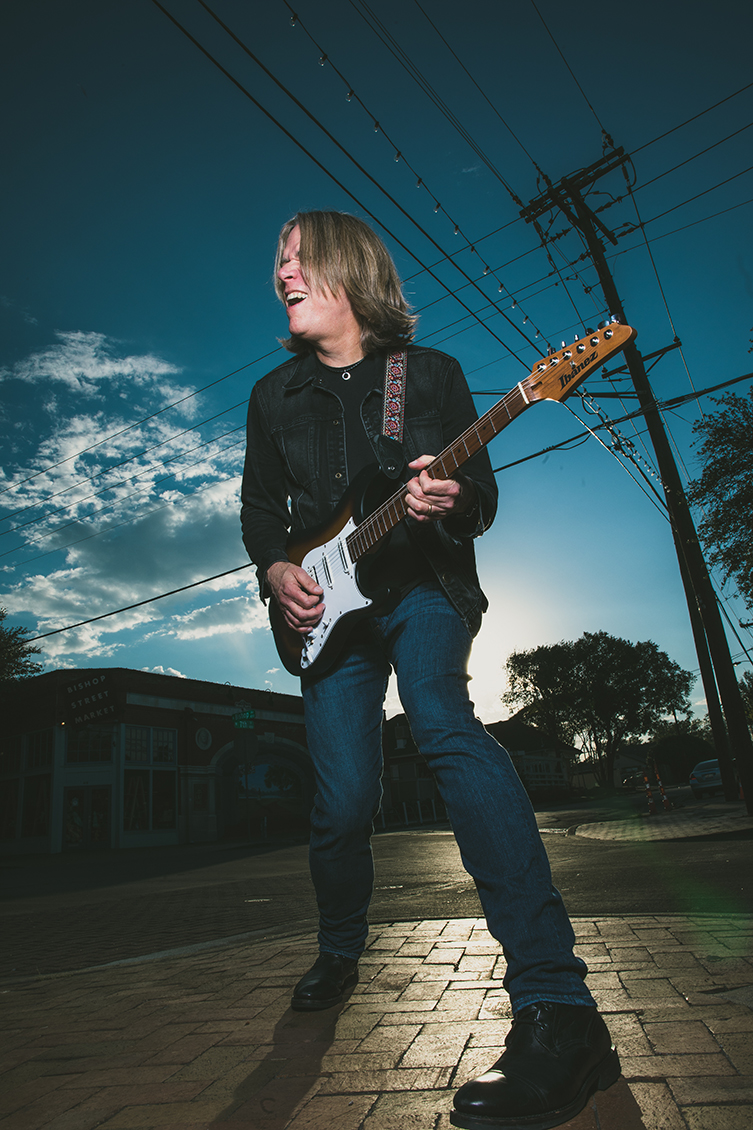
(Photo: Teresa Jolie)
GG: We just need to be as brave as these people, you know?
AT: That’s exactly right, because they could’ve just laid back and said, ‘I’ll just do that same record for the next thirty years’. Some people do! And that’s okay, but it’s not nearly as interesting, right?
GG: Exactly.
AT: It’s really important that every artist really follow their muse, where their heart is, you know?
GG: Certainly! You can’t really escape your influences, but by that turn, your ‘self’ shines through everything, regardless of style and so on.
AT: I hope so.
GG: Now, I was just about to talk about rhythm tones, but you were talking there about improvisation. I wonder about your solos: how much, in your own records, do you allow improvisation to happen? I was thinking about Take Me With You, the solo on that one?
AT: That’s all live, and the record very much has a live element to it because the bass, drums, guitar and keyboards were all recorded in the room together. Then, depending on how I thought about my performance, we’d keep it or try another take of it. So EWF is completely live as it happened; it might’ve been the first take, I can’t recall. None of the solos on Electric Truth are composed. I’m now not opposed to that. If I rewind to my Resolution record, that was the first record where I gave myself the permission to compose the solos. I improvised when we did the basic tracks for the record, and I just hated everything. I felt like I was just repeating myself, or it wasn’t good enough. It wasn’t up to a standard and I wanted to grow. Resolution was just one guitar, bass and drums.
"With all the crazy stuff in the world - the misinformation, disinformation - the music is true to me. I've got the music I love, I can trust that."
So, I took the improvised bits form the recording that I’d done, learned what I liked about them, but then gave myself permission to compose: ‘what would it take for me to really love this?’ You know? What would it take to make it exactly what I’d like to hear? That record, with a few exceptions, is completely written. Very little improvisation. By the time I’d gotten to where I was going to perform the song, I knew exactly what I wanted each note to sound like.
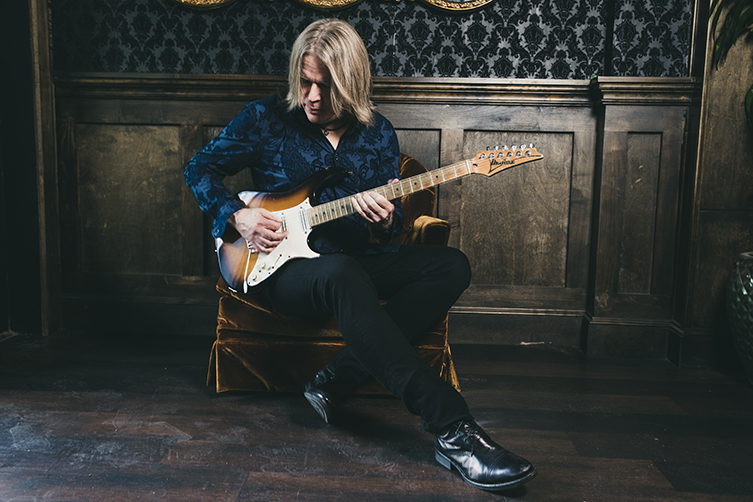
(Photo: Teresa Jolie)
It’s really handy when you can improvise on the live take to the level of ‘Oh, that was good!’, and that’s what I liked so much about EWF: there were a couple of places I go where I was like, ‘I’m not sure if that’s my favourite’, but it felt so good because it was a band playing live together. That’s the beauty of the record overall, for me.
GG: When you’re doing an improvised section on a given piece of music, are you thinking about making, for want of a better term, a complete statement? Like, a beginning, middle and end? And does that change if the band throws something at you mid-solo and changes direction?
AT: Yeah! Either compositionally or improvisationally, I’m wanting there to be an arch to the line. Im excluding the shreddy bits whenever those happen, those bursts of energy. But in general, I want it to be conversational, I want it to have shape, not just ‘Here’s some notes I know how to play!’ (laughs) It’s gotta have some shape, like we’re conversing now, it’s gotta have certain words, certain emphasis. When you hear a truly great player, you hear that in their phrasing and in their lines. I learned so much from Charlie Parker and his sense of dynamic: even his most dexterous lines are just stunningly panoramic. But yeah, you want there to be a beginning and an end, with hopefully a very interesting middle!
"There's definitely what I call the 'auralect'. It's the intellect of the ear: the instinct that you develop from all the things you've taken in."
GG: It’s so interesting talking to you, Andy, because this process you’re talking about can really be heard on the record. Now, briefly, the last two years have been difficult for all artists. I know you’ve spoken before about the connection between you as a musician and your guitar, how it’s been a personal deep thing that you’ve got. I wondered: was that connection something you could depend on throughout the pandemic?
AT: Oh, it’s my whole life. The last two years… weren't that different! (laughs) I mean, I know that’s a weird thing to say…
GG: No, I know what you mean.
AT: I’m not making light of the tragic, horrible thing that’s went on in the world on so many levels, but the guitar’s always been there for me. The guitar, and music, has always been there for me, it’s been my solace since as long as I can remember. I had my record player in my room, a guitar, and that was kinda my life. When I was younger, I was kinda shy and pretty introverted, and it was really my place to go. I think, through music, it could get to the point where I was less like that, and could be more extroverted when need be, but in general I still have some of that shy or withdrawn instinct. That’s kinda what Electric Truth is about. The basic idea of the record is: with all the crazy stuff in the world - the misinformation, disinformation - the music is true to me. I’ve got the music I love, I can trust that. Even if I’m just jamming to tracks or whatever, it’s a place for me to emote, to get out whatever I need to get out. And in writing, I can express these things, like in When Words Fail, the idea behind that song is that the written or spoken language is pretty finite, but the well-played and placed note may be able to go to deeper places than we’re able to verbally express.
Guitars
GG: Absolutely, and I believe a lot of people reading this will be able to relate. Now, I think it’s high time we dove into the subject of gear! I can’t wait to talk about your Ibanez models, but before we get to those, let’s talk about the guitars you used on Electric Truth. Did you have a variety to choose from?
AT: Yeah, the centrepiece of almost everything I do is the old Ibanez AT100. This is the prototype from 1994 that I’m still playing. This was particularly on solos like on Shuggy or Apocryphal, or the entire track of Take Me With You. Now, there’s a lot of other vintage guitars on the record. As I started writing tunes I was inspired by seeing Josh playing his old vintage Teles and Strats, so I was writing a few tunes on a lovely old ‘68 maple neck Telecaster. Most notably, you can really hear that on the opening track EWF: it’s got that middle position funky tone. That’s a live take with the band, so that’s the ‘68 Tele on the entire track. There’s a little bit of it on the main melody of Apocryphal, too.
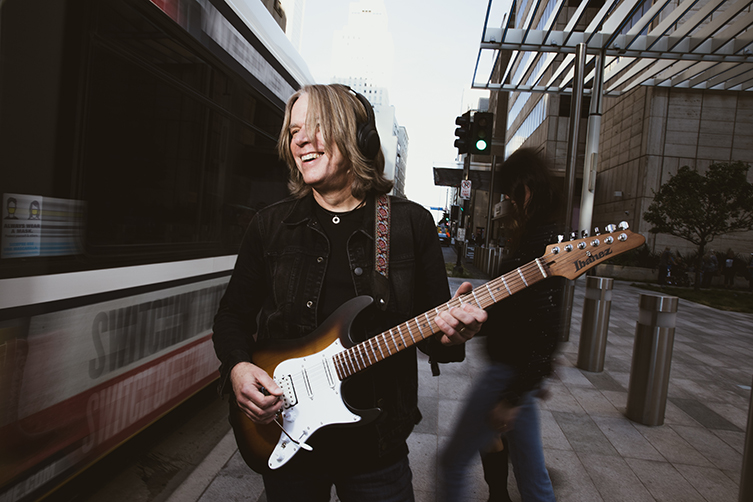
(Photo: Teresa Jolie)
Johnny T, the following tune, that's an early 90s Les Paul Standard. It’s tuned down a whole step with 13s on it. That song didn’t start out that way. That’s one tune that Josh wrote specifically for that record. I’d heard him and his band play this groove on a jam track he'd done for Truefire, and I said, ‘Man, give me a tune like that: I love that feel!’ He was like, ‘Oh yeah, that’s a Johnny Taylor groove!’ Okay, whatever, I like that! So he wrote that tune and played it in the key of D. We kept his track but I wasn't happy with how I was playing the song in general, so when I got back to my studio to work on it, I started to detune. It felt kinda swampy so I figured I’d tune the whole guitar down and get away with really heavy strings.
So, with the 13s on the Les Paul tuned down to D, it was very manageable but had a nice fat tone. It worked well! I think John Forgerty tuned his Les Paul a whole step down sometimes. There’s quite a few Creedence Clearwater Revival tunes where that guitar is tuned down a whole step, and it’s got a vibe to it, you know?
GG: Yeah!
AT: That’s why I put the tremolo on the very beginning of the song! It’s almost like CCR meets Billy Gibbons, cuz I got the Les Paul and the rock tone. I was a Les Paul guy growing up: one of my first guitars was an Electra Les Paul copy. That guitar got stolen sadly when I was 16 but the band I was in has an insurance policy, so when it got stolen I got to replace it with a Gibson Les Paul. So all through my early years, I was playing a Les Paul, until I got a Squier Strat in 1983 and started morphing over to the Strat style.
"I was steeped in The Beatles and Seventies rock, then I just developed a love for anything that had a guitar in it, basically."
GG: That’s interesting, Andy. Your guitar: obviously it’s an Ibanez but generally speaking, it’s a souped up Strat, right?
AT: Absolutely, yeah.
GG: And with the Les Paul, it’s a very different feel and I personally don’t find that I’m equally happy on both, I do prefer one over the other, even though I own both. Are you equally happy to switch between both?
AT: It matters greatly! If I’m on a stock vintage Strat or I’m on a Les Paul, then yeah, it’s gonna influence what you do. Hence this guitar, because I can bridge those worlds with the humbucker and slightly bolder hardware. I’m able to get between those worlds of sounds with one instrument, you know? This is not a new idea - the souped up strats have been around forever - but this is the version Ibanez do for me and I’ve been in love with and it’s my main guitar. Every now and then, to have that specific thing is also really cool. It’ll sound different, of course, and influence you to play differently. This whole record was kind of about that: it was me going to Josh’s studio, with him producing, him choosing the band, and just be included in the influence of a different circle of players. The way the band plays together is gonna bring different things out, and if I’m grabbing different instruments, it’s really fun! It’s gonna keep it fresh.
GG: Yeah! Now, your particular guitar: you’ve been with Ibanez for over thirty years now…
AT: Over thirty years, yeah! It kinda went by unnoticed! (laughs)
GG: How dare they! Let’s get an anniversary model going!
AT: (laughs) I know, right? It’s all good, I’m just kidding.
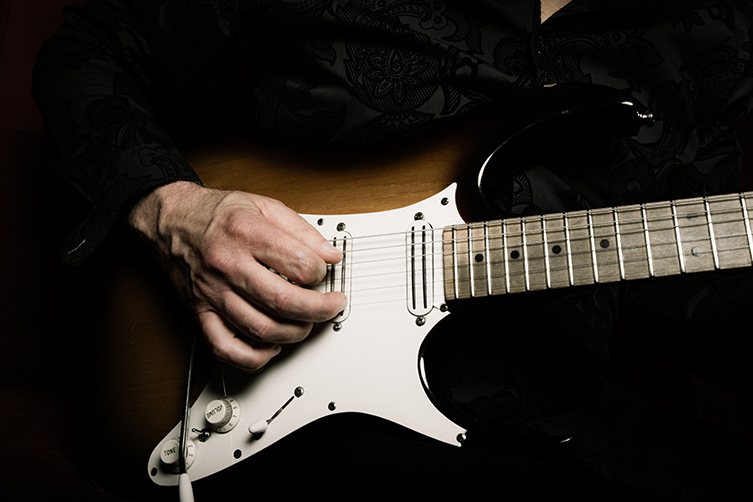
(Photo: Teresa Jolie)
GG: You’ve had a few variations of that type of that guitar, but they’ve all had those DiMarzio Cruisers. Now, I’ve had DiMarzio rails pickups myself, but they were always pretty hot, full-on humbuckers that were single coil-sized. Yours are still single-coil sounding, right? Because you’ve got such a beautiful Stratty sound.
AT: Thank you! And they are humbucking pickups but I can still get some of that delicate top end detail. It’s a little fatter, but it tends to match nice with the bridge humbucker. So it’s just something that was suggested to me when we built that guitar in 1994 and I stuck with it, so yeah, that’s it! I really didn;t go through a lot of experimentation (laughs), my friend Bill Kaminski at Ibanez said I should try them. I was using the Seymour Duncan Jeff Beck (formally known as the JB - Ray) at the time and they seemed to match real nice. At that time in my career, I wasn’t wanting to be mucking around a lot with wiring pickups and stuff, I just wanted to get on with playing, get on with music. Obviously I wanted the best tone possible but I hadn’t quite turned into an Eric Johnson disciple yet! All of the lore you hear about Eric - all these rabbit holes with cables and amps, well if you go down any of these particular paths, you realise very quickly that ‘oh shit, this makes a huge difference’, you know?
GG: Oh, right.
"It's really important that every artist really follows their muse, where their heart is, you know?"
AT: So, trying to balance that kind of obsessiveness with productivity and getting somewhere, but along the way learning a lot and trying to maintain as much of that purist mentality and trying to get the most organic signal path is still very much a thing for me.
GG: Yeah, that’s a good point. You have a wealth of tones on the record, but there’s still an overriding sound that I think of: it seems to me that you’ve got this sound that has loads of character in it, lots of sustain, but there’s not a ton of gain. Is that fair enough?
AT: Well, that’s…(laughs) Thank you, because that’s the key of the balancing act, especially with distorted guitar. The more gain we have, the easier it is to play, right?
GG: Exactly.
AT: But then the bandwidth of the sound gets narrower and narrower. You have less dynamic, less articulation, and the sound can get very buzzy, thin and harsh. Distortion can eventually be very harsh, so it’s about trying to keep it as warm as possible, having it be as articulate as possible, but you need enough gain…but I’m getting away with a lot of that with the use of my echo. That’s where a lot of sustain is also coming from. When the echo’s set right, the repeats become unnoticable. Digital effects, when they first came out, could be very exact, where the old analog and tape delays, the first repeat would start to duck and leave this beautiful palette behind you. I call it the ‘halo’, where the repeats would be slightly more and more out of tune as they’d go along. That’s what creates the beauty. Using real tape echoes was not cool for me because they take a lot of upkeep and they never work properly (laughs) so I started using the EHX Memory Man because those units had modulation available. The note stays pure but everything around it’s like the ripple in the lake. I call it the halo.
GG: So, when you’re recording your parts, would you have the effects on inline before they hit tape, so to speak? You don’t add them later with a plugin?
AT: Rarely will I use plugins. It’s not necessarily the recommended way of doing things, but when I print my effects, it’s coming through my cabinet exactly as I want to hear it. It’s a gamble: you can always add but you can’t take away. If I was smart, I’d do a dry cab, like a wet-dry-wet. I’m just not smart! But I commit! This is exactly what I want, and I don’t want anybody to be able to make a decision anywhere along the line that’s gonna take that away from me.
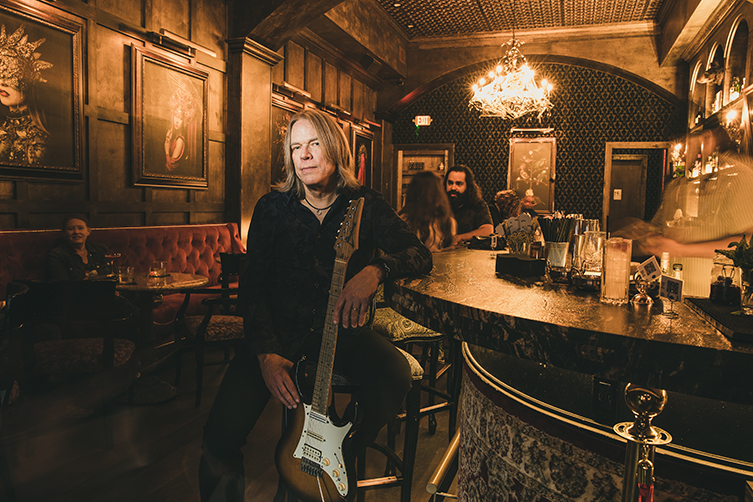
(Photo: Teresa Jolie)
GG: Certainly! Do you think the delay itself influences what you play as you hear it?
AT: Oh yeah! It’s not an effect to me, and this is something that was pointed out to me by my good friend Brian Meader at the Guitar Sanctuary. It’s really part of the sound. There’s much of my music that I couldn’t play, or wouldn’t feel or have the same emotional content without that component. I work on all of the tones with that in there, it’s part of the whole. It’s such a part of what I do: guilty as charged!
GG: It sounds amazing, so it’s pretty justified! You mentioned with the Les Paul that you used 13s: on your Ibanez, in standard tuning, what’s your preference?
AT: I use 10s. I’d used 9s throughout my early playing and decided I wanted to fatten up the tone. I ripped the heck out of my fingers making that transition!
GG: Would the bottom be like a 46? 10-46?
AT: Yeah, 10-46, exactly.
GG: Cool. And one thing I always ask guitar players - because I think not enough people talk about it - is what kind of pick do you prefer?
AT: Oh yeah, so this is interesting because this is the most consistent part of my signal chain. It’s a Dunlop Jazz III Tortex 1.14mm. Small stiffy, so to speak! (laughs) It’s weird, it was a guy at the music store I was teaching at when I was in Miami, he just said ‘try this pick!’ I immediately recognised the level of detail I was able to get. It’s got a really fine point at the end, the size didn’t bother me. I greatly prefer the tone of nylon though. For a while there, they made an XL nylon Jazz III for buckethead; he requested them, so that was a thing around 1999 or 2000. I was using that pick a lot. I even love the tone of a Fender Heavy, but so much of my technique has been developed over the years around this pick that I can’t get the detail and articulation with any other pick. I’m kind of in a way married to this pick. It is shocking though: if you have not done this when you’re tone questing, just get a jar full of picks. There are massive differences in tone and feel with all of these.
GG: Yeah, it’s crazy! So, with your Ibanez guitar, back when you first started it was a Les Paul copy, then a Gibson, a Strat and so on. How did Ibanez come into the picture for you, and what do they provide that really works for you?
AT: Well, prior to Ibanez, I was a Kramer endorsee. It was when I was with Danger Danger, and at that point, we were getting a lot of MTV video play so we were getting a pretty high profile. We were in all the teen glam metal magazines and all that. Strangely, in 1991, Kramer went out of business, after being on top of the heap with Eddie Van Halen and all of these great players. So, I was in a spot where I needed a company to work with and I was in a good position with a high profile band getting lots of exposure, so most companies at that point wanna work with you, regardless of your band or how you play, it’s about that exposure! For me, I knew I was headed towards where Vai and Satriani were. Ibanez was a likely choice, just because so many of my heroes and eventual friends were already there. The Ibanez A&R guy said, ‘We love you but we don’t like your band. Our program’s kinda full but I’ll see what I can do’.
"We just did most of the record in about two and a half days."
He came back and said they’d like to have me on, so that began a process. This was the first time in my life that somebody said to me, ‘We want to build you your ultimate guitar. What is it?’ And I went, ‘Six strings….I dunno! (laughs) I was always fortunate to have a guitar, and that’s not hyperbole. But to have a company ask that, I was like, I dunno, because I really didn’t know what that is. I’d owned so few guitars and really hadn’t experimented much, so they really went through the process with me, sending me all of their higher end guitars, like the US Custom line, which were really beautiful guitars with 24 frets and Floyds. Those were cool, and we did a Custom RG, a black guitar with purple pickups, but I remembered a Strat copy that Kramer had put together for me. That was my favourite neck, so I sent that to them and said ‘make it look like Eric Johnson’s ‘54 ‘Virginia’ Strat, I thought that was the most beautiful classic look. Some might think it’s boring because it’s not hot pink or cracked mirror or whatever! Those are all cool guitars but I’m very fond of vintage and classic like that.
So that neck and the RG was essentially what it was all about, It was the feel. We kept it with little to no finish on the neck, so it already felt like a guitar you’d played for years. Everything was kinda based on that.
GG: What’s interesting from listening to your record is that it’s not that immediately obvious to me when you’re playing a vintage guitar and when it’s one of your Ibanez models. That’s a great advert for how ‘vintage’ a newer guitar can sound, when it’s done right.
AT: I haven’t actually spoken directly to Ibanez about it, but my hope is that people realise that I’m gonna choose these vintage instruments occasionally for the studio, I'm not gonna take them on the road. Sometimes I like the way these guitars sound better in certain ways than those instruments. But there’s something about those old pickups. But no, those new ATZ’s sound phenomenal! For me though, I’m gonna hear those microscopic differences, which is why I chose those in the moment, but we’re not gonna be missing them live! Apart from if they’re visually influenced, because then there’s nothing I can do about it.
GG: True!
AT: I used to think that I could show up and make anything sound good, you know. Well, I was proven absolutely incorrect at this one gig I showed up to to sit in with a friend of mine. This other guitar player who had his rig there, man, I didn’t know what was going on but I couldn’t get anything to sound good! (laughs) So the gear does matter, folks! Your mind and your fingers are a big part of it, but oh my god, you need some help! Haha!
GG: Yeah, yeah! And on that subject, I was thinking of other sort of comparable players like for example Steve Vai, who has his famous ‘Evo’ guitar, which he likes over all of his other JEMs. I wondered, do you have an AT model that’s like that? Is it that original prototype that you’re playing today?
AT: Yeah, it is this guitar, absolutely. It’s funny because one of my fond things about travelling around is that at gigs, if there’s a meet and greet, a lot of people will bring their guitars if they’ve bought my signature guitars. There’s been many times where I’ve gone, ‘Hey, let me check that out, I wanna play that!’, because you wanna make sure that they’re making some great guitars and I’ve played some that were better! You can just tell: shit this is a good guitar! Trade ya! No, but this one has been refretted 8 times: there’s miles on this. I think there’s somewhat of a comfort factor in that. But I’m very happy to say that I do love all of them: I do record and use all of the different versions of my signature guitars but this is home. I call it my desert island guitar, as long as there’s electricity and an amp!

(Photo: Teresa Jolie)
GG: Hahaha, I like it! Now Andy, I know we are running out of time, so before I ask you about your plans for the record and the rest of 2022, I thought I’d ask for a tip: lots of guitarists will of course be reading this article, and so I wanted to ask about melody. Is there a tip or piece of advice you could pass on to those who are stuck in a rut, to help them develop their melodic sense?
AT: Sure. Let’s address melody first. The most basic answer is: as guitarists, we all learn the pentatonic scales and the Blues scale, we might delve into Modes. All of these are useful tools and you could make a lifetime of music just with the pentatonic. I reference Stevie Ray Vaughan a lot because he wouldn’t know a Mode if it bit him but he made music out of very basic tools, but just played it better than anybody else! (laughs) He had this conviction, this fire and this energy for a fairly finite amount of information, so know that we don’t need to know everything. There’s things that people get overwhelmed with because we have the entire world in our back pocket with everybody showing you everything you could ever wanna know in detail about anything, right?
GG: Sure.
AT: So, where do you go? Well, for playing melodically, this is so silly to say, but learn some melodies. Learn melodies, because most melodies don’t sound scalar, they don’t sound lick-ish. They are phrases that are sung. The scales and the Modes are supremely important to learn the guitar neck and that’s what it did for me. And it also helped me to see that by playing positionally, I started to see how it all blended together. And once I started visualising the guitar neck in more of a horizontal fashion, that led me to extract melodies in a different fashion. So learn melodies, and try to work on your horizontal playing.
And as far as the plans for the record go, it’s one of those projects where I wasn;t sure what would happen to it and when it would come out. So, I am happy to have it out, I’m heading to the UK in June with Daniel Steinhardt and Mick Taylor of That Pedal Show, we’re gonna do a few gigs around the UK, then a guitar camp in Italy right after that. It’s been a weird few years, so I’m happy to be home making music, doing lots of live streams, which I’ll continue to do, but of course I want to come out and play for everybody, as long as nobody is in danger! As long as the crowd and band can stay healthy, that’s the goal! And thanks to everybody for listening to the music, I’m very honoured by that.
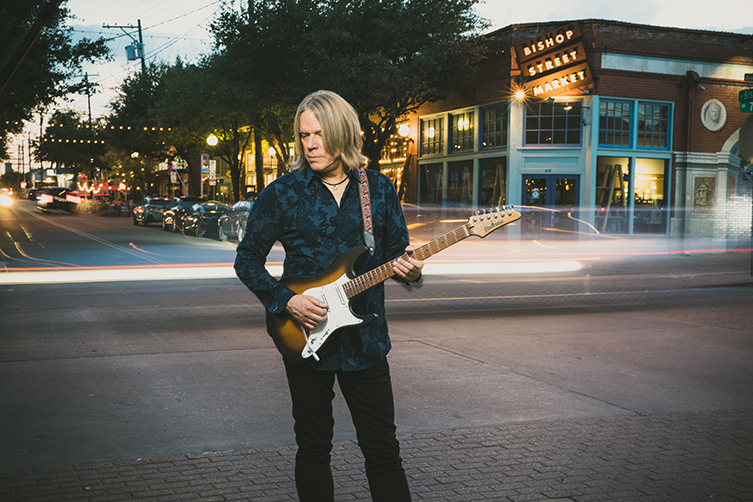
(Photo: Teresa Jolie)
That was a perfect note to end the second conversation on, and Andy duly went on to his next commitment. We actually had such a good time talking that much of the content had to be trimmed back due to the many tangents we went down! That’s the sign of a fun conversation, to be sure! Andy’s tips about melody learning near the end are particularly insightful, and players of all skill levels will surely benefit from a little focused attention in that direction.
Electric Truth is out now! Hopefully he’ll be playing in a city near you in the not too distant future, but until then, his new record is an excellent listen.
We;d like to thank Andy for giving us his time twice(!) and for being such a fun and inspiring person to speak to. Thanks also to Steve Karras for putting us in touch! As always, thank you for reading another guitarguitar interview! We appreciate you spending the time with us, and hope you enjoyed the journey. If you want more, we have recent interviews with artists like Steve Vai, Joe Satriani and many more in our guitarguitar Interviews section, so do click through there when you’re done here for more exclusive interviews.

